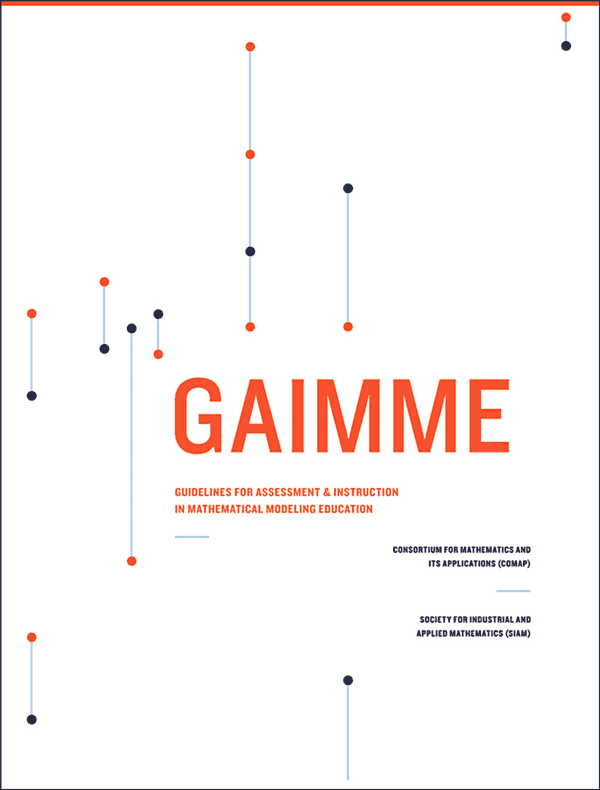
GAIMME
Guidelines for Assessment and Instruction in Mathematical Modeling Education
GAIMME, English Editions
The shared hope and vision of the Consortium for Mathematics and its Applications (COMAP) and the Society for Industrial and Applied Mathematics (SIAM) is that this report motivates the educational community to make a place for mathematical modeling in curriculum, from pre-K through undergraduate levels. Further, that the value and importance of the skills required to execute math modeling effectively - logical thinking, problem solving, sensitivity analysis, and communication to name a few - are recognized and nurtured.
Our primary audience is you the teacher. While we hope that test and policy makers will read this document and use it in their decision-making, it has been written for the front-line teacher. We hope and intend that these guidelines will be of help as you incorporate the practice of mathematical modeling into your classrooms.
A major reason for the creation of GAIMME was the fact that, despite the usefulness and value in demonstrating how mathematics can help analyze and guide decision making for real world messy problems, many people have limited experience with math modeling. We wanted to paint a clearer picture of mathematical modeling (what it is and what it isn't) as a process and how the teaching of that process can mature as students move through the grade bands, independent of the mathematical knowledge they may bring to bear.
The second edition includes changes primarily to the "Early and Middle Grades (K-8)" chapter. The GAIMME report is freely downloadable from both the SIAM and COMAP websites.
Contents
PREFACE
CHAPTER 1 WHAT IS MATHEMATICAL MODELING?
CHAPTER 2 MATHEMATICAL MODELING IN THE EARLY GRADES: PREKINDERGARTEN THROUGH GRADE 8
CHAPTER 3 MATHEMATICAL MODELING IN HIGH SCHOOL: GRADES 9 THROUGH 12
CHAPTER 4 MATHEMATICAL MODELING AT THE UNDERGRADUATE LEVEL
CHAPTER 5 WHAT IS MATHEMATICAL MODELING, THE ART AND FLAVOR
APPENDIX A MATHEMATICAL MODELING RESOURCES
APPENDIX B MODELING EXAMPLES, ELEMENTARY AND MIDDLE GRADES
APPENDIX C EXTENDED EXAMPLES
APPENDIX D ASSESSMENT TOOLS
REFERENCES
GAIMME, Chinese Edition
GAIMME: Guidelines for Assessment and Instruction in Mathematical Modeling Education Chinese Edition is for academic and pedagogical use only.
The shared hope and vision of the Consortium for Mathematics and its Applications (COMAP) and the Society for Industrial and Applied Mathematics (SIAM) is that this report motivates the educational community to make a place for mathematical modeling in curriculum, from pre-K through undergraduate levels. Further, that the value and importance of the skills required to execute math modeling effectively - logical thinking, problem solving, sensitivity analysis, and communication to name a few - are recognized and nurtured.
Our primary audience is you the teacher. While we hope that test and policy makers will read this document and use it in their decision-making, it has been written for the front-line teacher. We hope and intend that these guidelines will be of help as you incorporate the practice of mathematical modeling into your classrooms.
A major reason for the creation of GAIMME was the fact that, despite the usefulness and value in demonstrating how mathematics can help analyze and guide decision making for real world messy problems, many people have limited experience with math modeling. We wanted to paint a clearer picture of mathematical modeling (what it is and what it isn't) as a process and how the teaching of that process can mature as students move through the grade bands, independent of the mathematical knowledge they may bring to bear.
GAIMME, Spanish Edition
La esperanza y la visión compartidas del Consorcio para las Matemáticas y sus Aplicaciones (COMAP) y la Sociedad de Matemáticas Industriales y Aplicadas (SIAM) es que este informe motiva a la comunidad educativa a hacer un lugar para el modelado matemático en el currículo, desde preescolar hasta niveles de pregrado. Además, se reconoce y se nutre el valor y la importancia de las habilidades necesarias para ejecutar el modelado matemático de manera eficaz (pensamiento lógico, resolución de problemas, análisis de sensibilidad y comunicación, por nombrar algunos).
Nuestra audiencia principal eres tú, el maestro. Si bien esperamos que los encargados de las pruebas y las políticas lean este documento y lo utilicen en la toma de decisiones, ha sido escrito para el maestro de primera línea. Esperamos y tenemos la intención de que estas pautas sean de ayuda a medida que incorpore la práctica del modelado matemático en sus aulas.
Una de las principales razones para la creación de GAIMME fue el hecho de que, a pesar de la utilidad y el valor de demostrar cómo las matemáticas pueden ayudar a analizar y guiar la toma de decisiones para problemas complicados del mundo real, muchas personas tienen experiencia limitada con el modelado matemático. Queríamos pintar una imagen más clara del modelado matemático (qué es y qué no es) como un proceso y cómo la enseñanza de ese proceso puede madurar a medida que los estudiantes avanzan a través de las bandas de grado, independientemente del conocimiento matemático que puedan aportar. oso.
CONTENIDOS
PREFACIO CIAEM ii
PREFACIO iii
CAPÍTULO I ¿QUÉ ES LA MODELACIÓN MATEMÁTICA?
CAPÍTULO 2 MODELACIÓN MATEMÁTICA EN PRIMARIA Y MEDIA:
PREESCOLAR HASTA SEGUNDO AÑO DE SECUNDARIA
CAPÍTULO 3 MODELACIÓN MATEMÁTICA EN MEDIA SUPERIOR
CAPÍTULO 4 MODELACIÓN MATEMÁTICA EN EL NIVEL UNIVERSITARIO
CAPÍTULO 5 ¿QUÉ ES MODELACIÓN MATEMÁTICA?, EL ARTE Y SU SABOR
APÉNDICE A RECURSOS PARA LA MODELACIÓN MATEMÁTICA
APÉNDICE B EJEMPLOS DE MODELACIÓN, PRIMARIA Y SECUNDARIA
APÉNDICE C EJEMPLOS EXTENDIDOS
APÉNDICE D HERRAMIENTAS DE EVALUACIÓN
REFERENCIAS
If you use our resources in your classes, we invite you to gives us feedback on the site to tell us about your experience. You can also email us to identify errors, but please be as specific as possible when doing so (i.e., page number, question number).
For questions and comments please contact us here or email